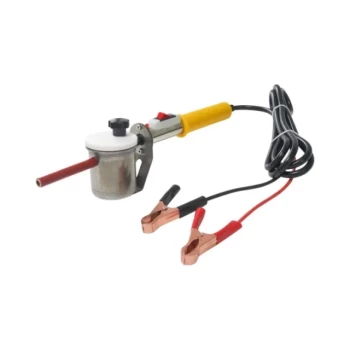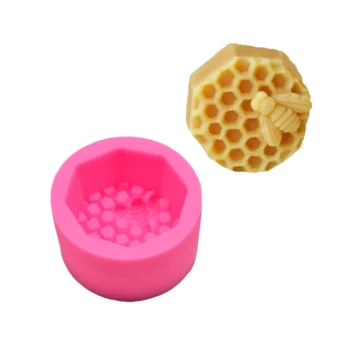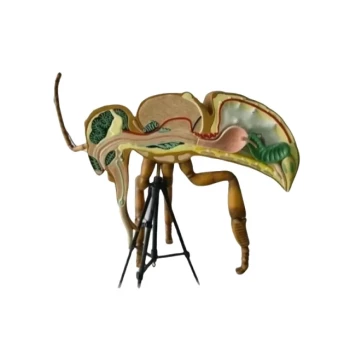At its core, the Varroa destructor mite devastates honey bee colonies through a two-pronged attack. It directly weakens bees by feeding on their vital internal tissues, and more critically, it acts as a vector, transmitting and amplifying deadly viruses throughout the hive. This combination reduces individual bee lifespan and inevitably leads to the collapse of untreated colonies.
The mite's direct parasitic feeding is damaging, but its role as a biological "hypodermic needle" for viruses like Deformed Wing Virus (DWV) is what transforms it from a simple pest into the single greatest threat to honey bee health worldwide.
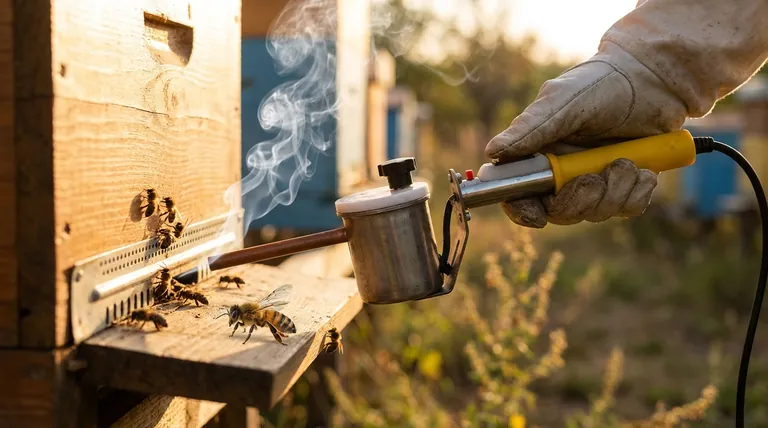
The Direct Impact on Individual Bees
The most visible damage from Varroa begins with how it harms a single bee. This direct parasitism weakens the bee from the moment it begins to develop.
Parasitic Feeding on the "Fat Body"
Mites feed on a crucial organ called the fat body. This is not simply fat; it is the bee's equivalent of a human liver, responsible for immune function, pesticide detoxification, energy storage, and regulating key hormones.
When a mite consumes the fat body, it is essentially robbing the bee of its primary energy reserve and a core part of its immune system.
Developmental Damage
When mites infest brood cells and feed on developing larvae and pupae, the damage is severe. The resulting adult bees are often underweight, physically smaller, and emerge already compromised.
This developmental harm directly impacts their ability to perform their future roles, whether as nurse bees, guards, or foragers.
Shortened Lifespan
A bee parasitized by Varroa will have a significantly shorter lifespan. The combination of nutrient loss from feeding and the stress of a compromised immune system makes them far more susceptible to the daily rigors of hive life, leading to premature death.
The Hidden Threat: Varroa as a Virus Vector
While the physical feeding is harmful, the mite's role in spreading disease is what causes catastrophic colony losses. Varroa mites are the primary vector for numerous honey bee viruses.
A Hypodermic Needle for Disease
As a mite pierces a bee's exoskeleton to feed, it simultaneously injects any viruses it carries directly into the bee's bloodstream (hemolymph). This bypasses the bee's natural external defenses, ensuring a successful infection.
The Deformed Wing Virus (DWV) Epidemic
The most notorious virus transmitted by Varroa is Deformed Wing Virus (DWV). In colonies with low mite levels, the virus may be present but cause no symptoms.
However, when Varroa populations increase, they amplify the virus to lethal levels. Bees emerge with shrunken, useless wings, paralysis, and a dramatically shortened life, dying within hours or days.
Amplifying the Viral Load
A honey bee colony can tolerate a low level of viruses. The presence of Varroa mites acts as an amplifier, creating a pandemic within the hive. Each mite's feeding is another infection event, causing the viral load within the colony to skyrocket past a point of no return.
From Individual Sickness to Colony Collapse
The effects on individual bees quickly cascade into a colony-level crisis. A hive is a superorganism, and its health depends on the strength of its individual members.
A Failing Workforce
As the population becomes dominated by sick, weak, and short-lived bees, the colony's workforce collapses. There are not enough healthy foragers to bring in nectar and pollen, and not enough healthy nurse bees to care for the brood.
The Winter Crisis
This weakness is especially fatal in the winter. A healthy colony survives by forming a tight cluster to generate heat. A colony weakened by mites and viruses cannot form an effective cluster, has insufficient food stores, and its bees do not live long enough to make it to spring.
The Tipping Point
Eventually, the colony reaches a tipping point. The death rate of adult bees surpasses the queen's ability to lay new eggs and replace them. At this stage, the colony's population dwindles rapidly, leading to its ultimate collapse.
Understanding the Trade-offs: The Challenge of Control
Recognizing the severity of Varroa is critical for anyone managing honey bees. The problem is complex and requires a proactive mindset.
The Inevitability of Infestation
Without intervention, a honey bee colony has virtually no chance of surviving a Varroa infestation long-term. The mites reproduce so efficiently that their population will inevitably overwhelm the hive.
The Treatment Dilemma
Controlling mites almost always requires the use of treatments (miticides). This presents its own challenge, as beekeepers must carefully select, rotate, and apply treatments to be effective while minimizing risk to the bees and preventing the mites from developing resistance.
How to Apply This Knowledge
Understanding these devastating effects is the first step toward effective management and protecting honey bee populations.
- If your primary focus is diagnosis: Realize that visible symptoms, such as deformed wings, are late-stage indicators of a severe infestation. Proactive monitoring for mite levels before these signs appear is essential.
- If your primary focus is colony survival: A consistent, year-round Integrated Pest Management (IPM) plan to keep mite populations low is the only viable long-term strategy.
- If your primary focus is bee health: See Varroa not as a pest but as a disease catalyst. Managing mites is the single most important component of managing your colony's overall health.
Proactive and vigilant Varroa mite management is the defining action a beekeeper must take to ensure the health and long-term survival of their bees.
Summary Table:
| Aspect of Impact | Key Effect on Honey Bees | Result for the Colony |
|---|---|---|
| Direct Parasitism | Feeds on fat body, causing underweight bees & shortened lifespan. | Weakened workforce and reduced foraging efficiency. |
| Virus Transmission | Acts as a vector for Deformed Wing Virus (DWV) and others. | Viral amplification leading to widespread disease and death. |
| Colony-Level Crisis | Failing workforce cannot support brood or winter cluster. | Inevitable population decline and eventual collapse. |
Protect Your Apiary with Professional-Grade Equipment
Varroa mites are a relentless threat, but a strong defense starts with the right tools. HONESTBEE supplies commercial apiaries and beekeeping equipment distributors with the durable, effective supplies needed for a robust Integrated Pest Management (IPM) plan. From mite monitoring kits to treatment solutions, our wholesale-focused operations ensure you have access to the equipment that protects your investment and promotes hive health.
Don't let mites decimate your colonies. Contact our expert team today to discuss your needs and secure the reliable supplies your business depends on.
Visual Guide
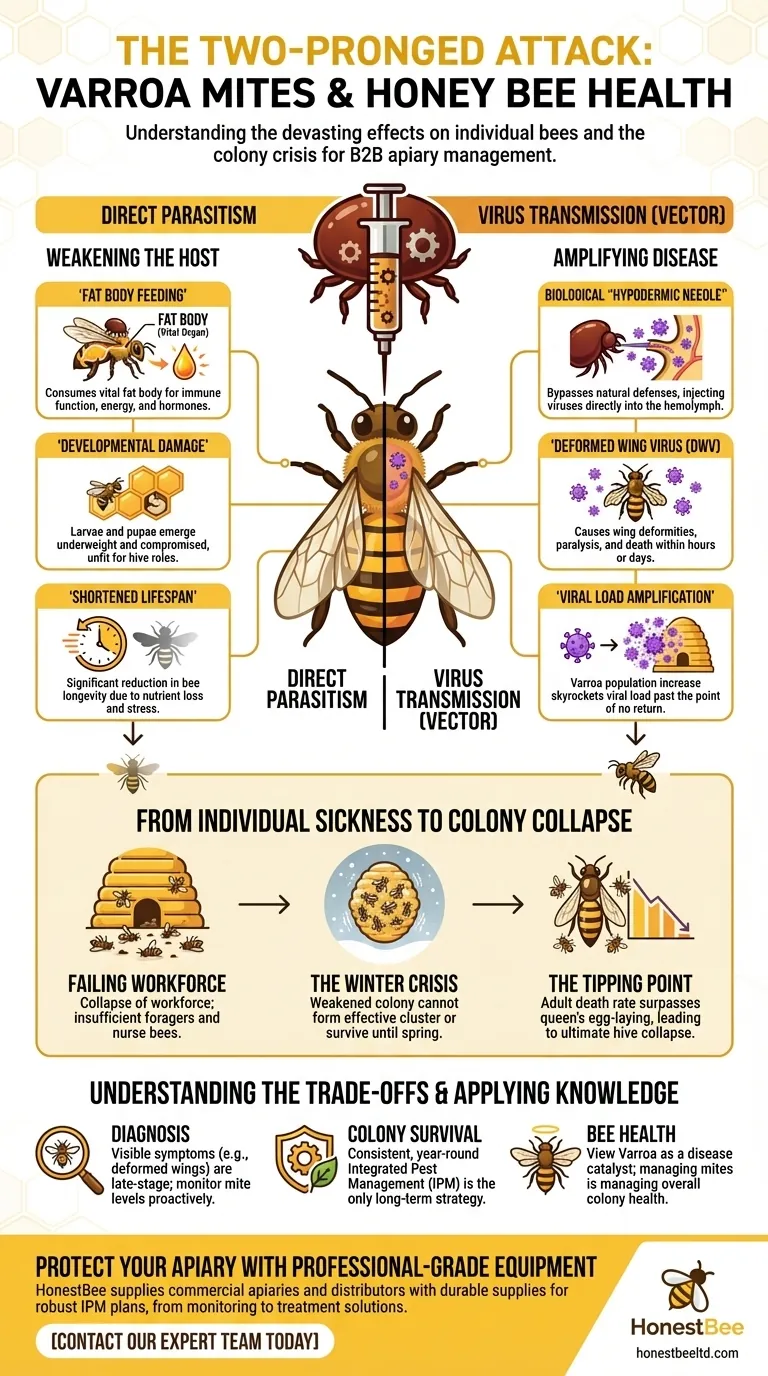
Related Products
- 12V Bee Mite Removal Evaporator Oxalic Acid Vaporizer for Bee Fumigation Treatment 180W Atomization
- Professional Bamboo Queen Isolation Cage
- Professional Plastic Queen Excluder for Modern Beekeeping
- Premium Wood Framed Metal Wire Queen Bee Excluder
- Metal Queen Bee Excluder for Beekeeping
People Also Ask
- What are the methods of administering oxalic acid against Varroa? Drip vs. Sublimation Explained
- When is the best time to perform Oxalic Acid Vaporization? Maximize Mite Control for Healthy Hives
- What are the registered application methods for oxalic acid in beekeeping? Choose the Right Varroa Mite Treatment
- What are the two popular methods for applying oxalic acid? Choose the Best Varroa Mite Treatment
- Can oxalic acid vaporization be used with honey supers on the hive? Ensure Legal Compliance & Honey Safety
